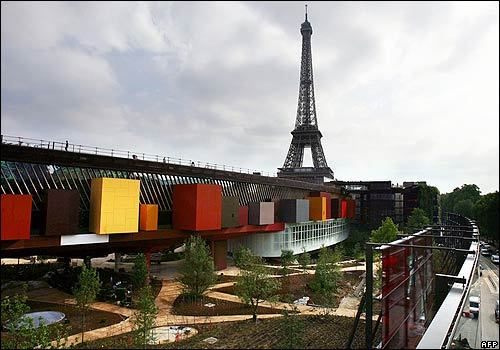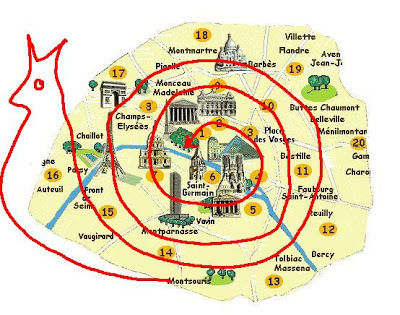No, the city is not on lockdown. After the recent dramatic flooding by the expanding river Seine, visitors will be happy to return to the capital where summers are mostly dry. Today, the water is already receding - in any case, affected areas were mostly alongside the river.
Paris is shaped as a snail (escargot in French). Look at a map of the city from above, and you will see that the 20 parts of Paris - the arrondissements - are unfolding from the very center to the outside rim of town in a circular clockwise way. No arrondissement is better than the others, but they each do have specific attractions that you may want to know about before visiting.
Numbered from one to 20, the metropolis districts unroll from le premier arrondissement (the 1st), to its last tail part, the 20ième arrondissement (the 20th). Each arrondissement has more than one or two interesting points, but I picked here some of my favorites.
Six arrondissements are located on the Left Bank of the Seine (Rive Gauche), the other 14 are on the Right Bank (Rive Droite). Yes, the traffic in Paris goes at snail pace, so better take the subway (le métro) to visit with less stress.
The 1st: This is the heart of the city, and I mean the geometrical center, not necessarily the most vibrant. This is where the majestic Musée du Louvre and its grand pyramid entrance welcome art lovers. The adjoining Tuileries gardens are a favorite of little Parisians. Métro stop Louvre.
The 2nd: The smallest of them all, at 245 acres. Where many of Paris covered passages are located, nice indoor walks for unique shopping experience when the elements are not participating. Métro Bourse.
The 3rd: Beaubourg Centre Pompidou. The modern art museum still spelling controversy thanks to its unique architecture, several floors of art and then, that escalator! Best views of Paris rooftops. Métro Beaubourg.
The 4th: Musée Picasso. And the Place des Vosges - the oldest town square of Paris, and the Marais, a chic and quiet enclave. And don't forget Notre Dame and the Ile de la Cité. Métro Saint Paul.
The 5th: The infamous center of the 1968 students' revolution, it has kept the hippie feel and relaxed atmosphere of young students and lingering extremism. Nicknamed the Latin Quarter. Planted in 1601, this is where the oldest tree of the city majestically rest in the center of Square Viviani. Métro Saint Michel.
The 6th: Luxembourg gardens. Magnificent former royal green gardens, this is where the original model of the Statue of Liberty stands erected. Métro Luxembourg.
The 7th: Tour Eiffel - enough said, and the Musée du Quai Branly, featuring indigenous art and cultures of Africa, Asia, Oceania, and the Americas, in a funky line-up of earth colors boxes. Métro Pont de l'Alma.
The 8th: Champs-Elysées/ Concorde/Arc de Triomphe = all nice spots to visit. Plus the amazing Petit Palais and its grandiose outdoor café. Métro Champs-Elysées-Clémenceau.
The 9th: Opéra Palais Garnier. Gold studded architectural masterpiece, for fans of arias. Also, all the large department stores of Paris are located here. Métro Opéra.
The 10th: Canal Saint Martin. Detailed iron footbridges and tree-shaded quays form a unique backdrop to some of the best foodies joints in the capital. A leisure walk along the waterway is enough to make you think you left the city for a weekend trip. Métro Louis Blanc.
The 11th: Cornered by Place de la Bastille, Place de la République, and the Père Lachaise cemetery, the area is home to the Edith Piaf museum (by appointment only), the Bastille column centerpiece and the opera house, and one of the best brasserie of Paris, Bofinger. Métro stops: Bastille, République, Voltaire.
The 12th: Giant columns frame the avenue where my favorite open air market takes place at the roundabout Place de la Nation on Wednesdays and Saturdays. Métro Nation.
The 13th: This is where the small Chinatown part of Paris is - clothing stores and groceries, plus some authentic restaurants, frequented by an Asian crowd, always a good sign. Métro Place d'Italie.
The 14th: Where the controversial 58-floor tower sits un-pretty on top of a train station, the Montparnasse neighborhood is home to several movie theaters and the best crèpes restaurants in the city. It also has a very nice old-fashion cemetery, with its population of feral cats. Jean-Paul Sartre, a resident of the district, is buried there. Métro Montparnasse.
The 15th: The lovely Parc André Citroën, built on the former car factory site, is designed with six themed gardens each associated with a different metal, a planet, a day of the week, a state of the water, and a sense. Also here, the Pont de Bir-Hakeim straddles the Seine and offers the best view of the Eiffel Tower from the subway cars, which is aerial at that point. The steel bridge has two levels, one for cars and walkers, the higher one for the Line #6 of the métro. Métro stops: Bir-Hakeim and Balard.
The 16th: With its ornate 19th-century buildings, wide avenues, and prestigious schools, this arrondissement has been called a ritzy area, and is often associated with wealth in popular culture. This is where the Bois de Boulogne and the Jardin d'Acclimation are located, also hosting the new edgy Louis Vuitton foundation art museum, a must-see. Métro Les Sablons and Ranelagh.
The 17th: Place Clichy is the heart of the district, with movie theaters, hot and sexy night joints, and the best fabric and discount clothing anywhere in the city. Home to the Square des Batignolles, a four-acre green space designed in English-garden style. Métro Place Clichy or La Fourche.
The 18th: Montmartre. With its fun funicular, Sacré Coeur basilica, vineyards, and street artists, plus the magnificent views of the city below, it's a very popular area with tourists (hint: always busy). I like the steep hills and cobbled streets. Métro Abbesses.
The 19th: The Buttes-Chaumont gardens. High up on a hill, one of the best viewpoints of the city. With grotto, cascade, pebbles trails, meandering river, ducks and green lawn, this flower garden is one of my favorite nature park of Paris. Métro Buttes Chaumont.
The 20th: Ménilmontant and Belleville, two neighborhood of real immigration flavor, with North Africa dishes such as couscous and méchoui at street stands everywhere, cheap clothes and friendly faces drinking green tea in tiny glasses at outside terraces. Also home to the Père Lachaise cemetery, eternal home of Jim Morrison. Métro Père Lachaise.
No matter where you find yourself, there will always be a boulangerie (bakery) at every corner. I was born in the 18th, lived in the 1st, 8th, 14th, 17th, 19th, and 20th. And just like other major cities, certain zip codes are trendier than others, with real estate value sometimes going bonkers from one district to the next.
Under the Romans, Lutetia had a population of about 8,000 and was re-baptized Paris in 360 A.D. Today the population of the city is 2, 4 million residents (2014 census), a strangely lower number than in 1921 when it was almost 3 million.
Questions / Comments = sidoniesawyer@gmail.com
Visit my website for more stories.


